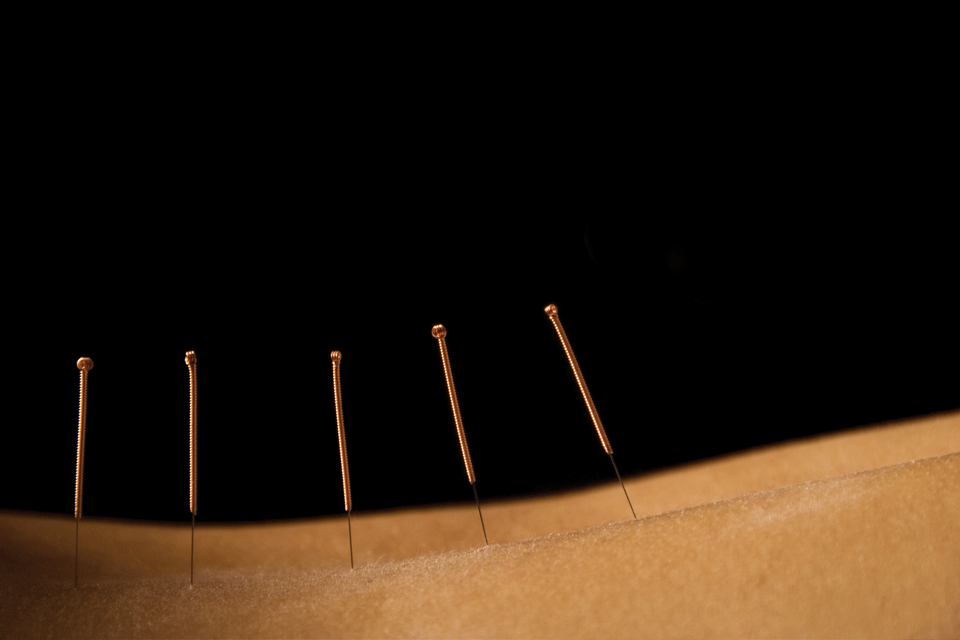FAQ: Acupuncture

Many people cringe at the thought of needles, but using acupuncture needles to treat your pain and ailments can be a huge source of relief. Matthew Kirsch of Kirsch Method Acupuncture and Bodywork dispels any fears or misconceptions about getting this kind of work done.
Needles are the first thing people think of when they hear ‘acupuncture treatment,’ but you’re not using big, threatening tools. How do you dispel these fears for first-time clients? Normally I show them the needle but I also describe it. A syringe is a 20 gauge needle, and 22 of them can fit in one inch. Acupuncture needles are 32 to 44 gauge needles, which means 32 to 44 of them can fit in one inch—they’re much smaller. When you show a person the needle, they’re able to see how hair-thin they are.
I also tell new patients that they can expect two kinds of sensations. One feels like a flash of electricity or movement away from the needle. This is good—it means some stagnation has dispersed, so the person will get good result in pain relief. The second is a dull throb sensation that feels like it’s building underneath the needle. This is also good—these points directed toward nourishing a deficiency within an organ system mean that system is beginning to resource and gather energy.
What are the main reasons people come in to get acupuncture? Most people seek acupuncture for pain. Normally they’ve been in chronic pain for a long time and they’ve tried many different things that haven’t helped. It’s common to come in seeking relief from headaches, migraines, aching back pain, carpal tunnel, and TMJ. In the process, many people are surprised to find acupuncture’s benefit to pain and discomfort arising from internal imbalances through the respiratory, digestive, and reproductive systems and autoimmune diseases. In Austin, it’s common for people to come in to treat their allergies. Acupuncture can benefit during the acute stuffy sneezing presentation and help long term in strengthening the immune system.
Let’s say I have a really painful knot in my back. Physiologically speaking, how can acupuncture target that spot and help relieve my pain? Physiologically, we know the brain and the skin develop from the same ectoderm, so when we stimulate the skin at an acupuncture point, we stimulate the central nervous system to relay to motor nerves that innervate tissue to do a specific function better.
Pain and stagnation are synonymous, meaning circulation needs to happen to resolve the painful place. Needling at the place of pain can break up this stagnation, while also needling points away from the pain on the same or connecting channel will provide a movement or exit for the pain.
Think of it this way: When a car accident happens, police are usually first to arrive and secure the scene to keep the area safe and provide immediate support. That is the knot. The knot serves the purpose of preserving integrity until more help can arrive. Then, the ambulance arrives to provide transport to the hospital for care. That is part of restoration of circulation. Then, police and fire can clean up the scene until it’s cleared and all lanes are once again open for movement. That is the other part of restoration of circulation and healing. We can see how the person needing the ambulance and the people stuck in traffic are both experiencing pain. One is the root, and the other is the resulting inflammation—acupuncture works to restore flow resolving both pain and inflammation.
This is a practice that has been around for centuries. Are there any new developments still happening in the field? Among the most exciting movements are in research. Studies pairing acupuncture with MRIs show that the brain lights up with the insertion of acupuncture needles and different points will stimulate different areas of the brain. Other research that focused on participants in pain showed a faster healing process using acupuncture.
Is acupuncture typically covered by insurance? Mostly, yes. More and more insurance companies are covering acupuncture. It depends on the person’s policy, but for most people coming in, it’s covered.






